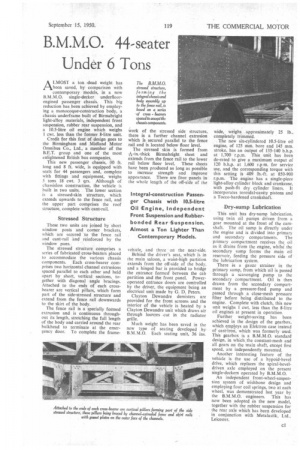B.M.M.O. 44-seater Under 6 Tons
Page 43

If you've noticed an error in this article please click here to report it so we can fix it.
ALMOST a ton dead weight has been saved, by comparison with contemporary models, in a new B.M.M.O. single-decker underfloorengined passenger chassis. This big reduction has been achieved by employing a monocoque-construction body, a chassis underframe built of Birmabright light-alloy materials, independent front suspension, rubber rear suspension, and a 10.5-litre oil engine which weighs I cwt. less than the former 8-litre unit.
Credit for this feat of design goes to the Birmingham and Midland Motor Omnibus Co., Ltd., a member of the B.E.T. group and one of the most enlightened British bus companies.
This new passenger chassis, -30 ft. long and 8 ft. wide, is equipped with seats for 44 passengers and, complete with fittings and equipment, weighs 5 tons 18 cwt. 3 qrs. Although of chassisless construction, the vehicle is built in two units. The lower section is a stressed-skin structure, which extends upwards to the fence rail, and the upper part comprises the roof structure, complete with cant-rail.
Stressed Structure These two units are joined by short window posts and corner brackets, which are secured to the fence rail and cant-rail and reinforced by the window pans.
The stressed structure comprises a series of fabricated cross-bearers placed to accommodate the various chassis components. Each cross-bearer comprises two horizontal channel extrusions spaced parallel to each other and held apart by short, vertical sections, together with diagonal angle bracings. Attached to the ends of each crosshearer are vertical pillars, which form part of the side-stressed structure and extend from the fence rail downwards to the skirt of the body.
The fence rail is a specially formed extrusion and is continuous throughout its length, stretching the full length of the body and carried around the rear bulkhead to terminate at the emeruency door. To complete the frame work of the stressed side structure, there is a further channel extrusion which is secured parallel to the fence rail and is located below floor level.
The stressed skin is formed from Birmabright sheet and extends from the fence rail to the lower rail below floor level. These sheets have been produced as long as possible to increase strength and improve appearance. There are four panels in the whole length of the off-side of the vehicle, and three on the near-side. Behind the driver's seat, which is in the main saloon, a waist-high partition extends from the off-side of the body, and a binged bar is provided to bridge the entrance formed between the cab partition and the front panel. Poweroperated entrance doors are controlled by the driver, the equipment being an electrical unit made by G. D. Peters, Clayton Dewandre demisters are provided for the front screens and the interior of the vehicle is heated by a Clayton Dewandre unit which draws air through louvres cut in the radiator grille.
Much weight has been saved in the new type of seating developed by B.M.M.O. Each seating unit, 36 ins. wide, weighs approximately 25 lb.. completely trimmed.
The new six-cylindercd 10.5-litre oil engine, of 125 mm. bore and 145 mm. stroke, has an output of 135-140 b.h.p. at 1,700 r.p.m. This unit has been de-rated to give a maximum output of 120 b.h.p. at 1,600 r.p m. for service use, and the corresponding torque with this setting is 409 lb.-ft. at 850-900 r.p.m. The engine has a single-piece light-alloy cylinder block and crankcase, with push-fit dry cylinder liners. It incorporates toroidal-cavity pistons and a Tocco-hardened crankshaft.
Dry-sump Lubrication
This unit has dry-sump lubrication, using twin oil pumps driven from a gear mounted at the front of the camshaft. The oil sump is directly under the engine and is divided into primary and secondary compartments. The primary compartment receives the oil as it drains from the engine, whilst the secondary sump forms the main oil reservoir, feeding the pressure side of the lubrication system.
There is a gauze strainer in the primary sump, from which oil is passed through a scavenging pump to the secondary compartment. Oil is then drawn from the secondary compartment by a pressure-feed pump and passed through a close-mesh pressure filter before being distributed to the engine. Complete with clutch, this new unit weighs I cwt. less than the 8-litre oil engines at present in operation.
Further weight-saving has been achieved in the design of the gearbox, which employs an Elektron case instead of cast-iron, which was formerly used. This gearbox is a B.M.M.O. standard design, in which,the constant-mesh and all gears on the main shaft, except first speed, are independently mounted.
Another interesting feature of the vehicle is the use of a hypoid-bevel drive, which replaces the spiral-beveldriven axle employed on the present single-deckers operated by B.M.M.O.
An independent front-wheel-suspension system of wishbone design and employing four coil springs, two at each wheel, was demonstrated last year by the B.M.M.O. engineers. This has now been adopted in the new model, together with the rubber suspension for the rear axle which has been developed in conjunction with Metalastik, Ltd., Leicester.




































































































